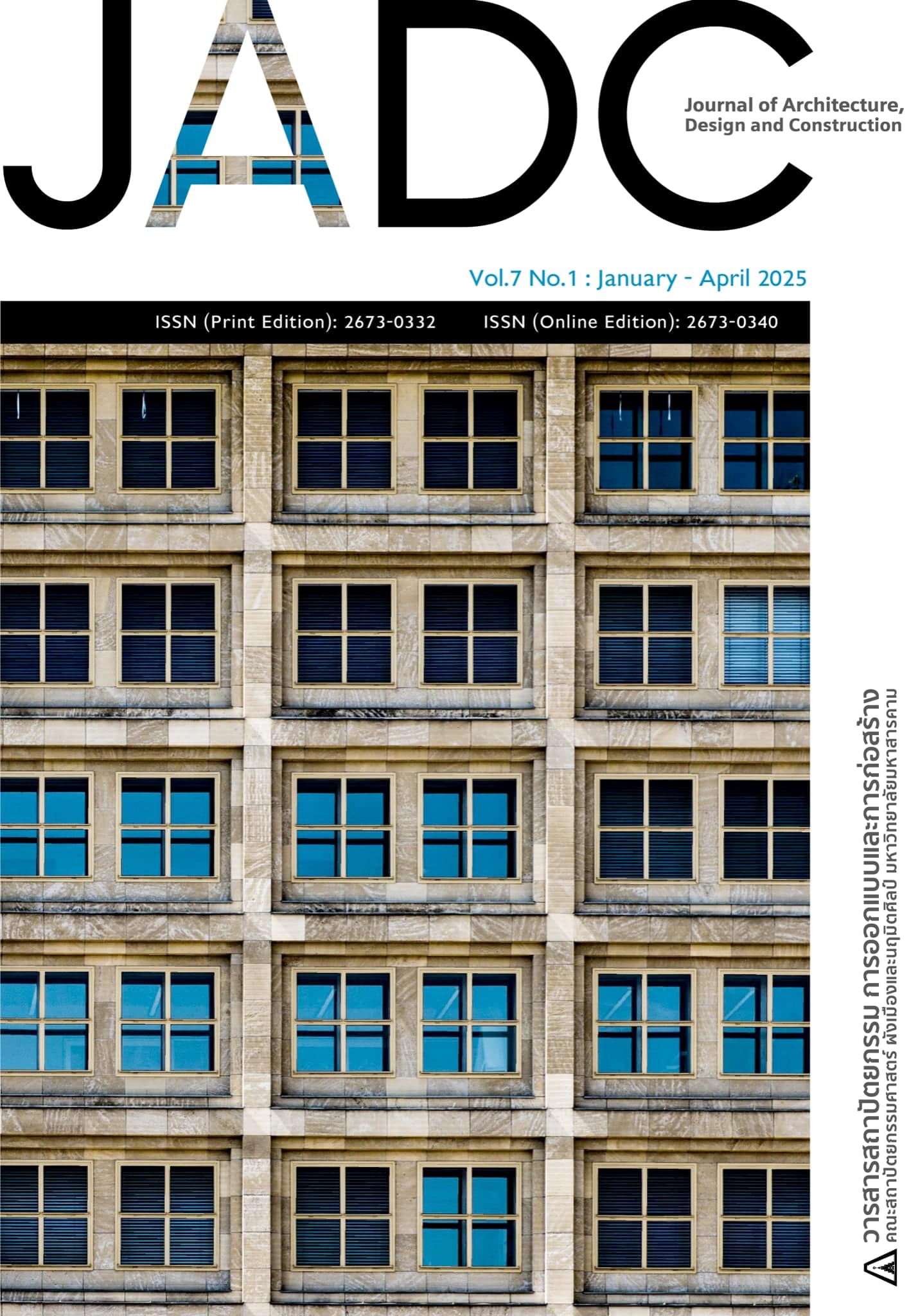The Art of the Auspicious Victory Drum applied to the Interior Architecture of the Prototype Community Cultural Center, Ban Mae Klang Luang, Chiang Mai Province
Main Article Content
Abstract
This research article aims to study the art of the auspicious victory drum, the user groups within the project, and the needs of the surrounding contextual area of the Ban Mae Klang Luang Prototype Community Cultural Center in Chiang Mai Province. The study analyzes and applies the findings to design the interior architecture of the Ban Mae Klang Luang Prototype Community Cultural Center in Chiang Mai Province. This research employs a mixed method approach, utilizing a qualitative approach through in-depth interviews focusing on the art of the auspicious victory drum with experts and those involved in the management of community cultural centers in various aspects, and a quantitative approach by collecting data through questionnaires from community members, Thai and foreign tourists that interested in the Community Culture of Ban Mae Klang Luang, to assess the suitability of applying the concept of the auspicious victory drum and to inquire about the spatial needs of both service providers and users. The analysis of the auspicious victory drum art, regarding the aspect of significance value, spiritual power, creation rituals, and playing regulations, led to the summarization of the key concept: “Chai Mangkhala – Sacred Drum Brings Auspiciousness.” This concept was then used to develop the interior architectural design of the Ban Mae Klang Luang Prototype Community Cultural Center in Chiang Mai Province. The evaluation of the design's suitability was positive. The assessment of the spatial needs of both service providers and users revealed that the community desired furniture designs that could be adapted for various activities, as well as the use of local materials. These findings were subsequently applied to the interior architectural design of the Ban Mae Klang Luang Prototype Community Cultural Center in Chiang Mai Province, focusing on the layout, visual aesthetics, and furniture within the exhibition space. The overall satisfaction assessment from a sample of 100 individuals showed a “good” level of satisfaction, with a mean score (𝑥̅) of 3.92 and a standard deviation (S.D.) of 0.72.
Downloads
Article Details

This work is licensed under a Creative Commons Attribution-NonCommercial-NoDerivatives 4.0 International License.
The articles published in the Journal of Architecture, Design and Construction are the intellectual property of the Faculty of Architecture, Urban Design and Creative Arts, Mahasarakham University.
References
กระทรวงการท่องเที่ยวและกีฬา. (2565, 21 มกราคม). สรุปสถานการณ์พักแรม จำนวนผู้เยี่ยมเยือน และรายได้จากผู้เยี่ยมเยือน เดือนมกราคม - ธันวาคม 2564. https://www.mots.go.th/news/category/630
กรมส่งเสริมวัฒนธรรม กระทรวงวัฒนธรรม. (2555, 19 มีนาคม). กลองชัยมงคล. [Video]. YouTube. https://www.youtube.com/watch?v=DcXJJJvaFms&t=104s
กรมส่งเสริมวัฒนธรรม กระทรวงวัฒนธรรม. (2556, 22 สิงหาคม). ศิลปะการแสดงชัยมงคล1. [Video]. YouTube. https://www.youtube.com/watch?v=ObLdgeJvm28
ชัชวาลย์ ทองดีเลิศ. (2553). องค์ความรู้กลองชัยยะมงคล. โฮงเฮียนสืบสานภูมิปัญญาล้านนา.
ดิษฐ์ พิยารมย์. (2553). องค์ความรู้ศิลปินแห่งชาติ นายมานพ ยาระณะ. (งานวิจัยอิสระโครงการวิจัยศิลปวัฒนธรรม). สำนักงานกรรมการวัฒนธรรมแห่งชาติ กระทรวงวัฒนธรรม.
ที่นี่โอเค. (2563, 18 สิงหาคม). กลองชัยมงคล คติความเชื่อเกี่ยวกับการตีกลองแบบต่าง ๆ ของชาวล้านนา. [Video]. YouTube. https://www.youtube.com/watch?v=xXpBfy6Aj0M
พระนคร ปญฺญาวชิโร. (2555). กลองในพระไตรปิฎกที่ปรากฎในล้านนา. สำนักพิมพ์มรดกล้านนา.
พระศักดิ์สกล สกฺกมหิทฺธิมลาวิโก (ผลสนอง), พระครูปริยัติพัฒนบัณฑิต, พระครูสุธีคัมภีรญาณ และ เพลิงสุริยเทพ รามางกูร ณ โคตะปุระ. (2566). กลองในพระพุทธศาสนาเถรวาท. Journal of Roi Kaensarn Academi, 8(11), 767–780.
พิพัฒน์ เสียงชารี. (2551). การศึกษากลองชัยยะมงคลของนายมานพ ยาระณะ จังหวัดเชียงใหม่. มหาวิทยาลัยศรีนครินทรวิโรฒ.
รณชิต แม้นมาลัย. (2536). กลองหลวงล้านนาและความสัมพันธ์ระหว่างชีวิตกับชาติพันธุ์. [วิทยานิพนธ์ปริญญาศิลปะศาสตร์มหาบัณฑิต, ไม่ได้ตีพิมพ์]. มหาวิทยาลัยมหิดล.
รณฤทธิ์ ไหมทอง. (2566). กลองขุมดิน มรดกภูมิปัญญาทางวัฒนธรรมดนตรีล้านนา. วารสารดนตรีและการแสดง, 9(2), 96–109.
วิลาวัณย์ เศวตเศรนี. (2555). ภูมิปัญญาเชิงช่างเชียงใหม่. สำนักส่งเสริมศิลปวัฒนธรรม มหาวิทยาลัยเชียงใหม่.
สนั่น ธรรมธิ. (2550). นาฏดุริยการล้านนา. สุเทพการพิมพ์.
สารสนเทศภูมิปัญญาท้องถิ่น ภาคเหนือ. (2555, 4 ตุลาคม). เครื่องดนตรีและอุปกรณ์ในการแสดงตีกลองชัยมงคล. http://bansanpakoy.blogspot.com/2012/10/
สิปปกร ขจรกุลจรรยา, ทิพวรรณ ทั่งมั่งมี และฉลองเดช คูภานุมาต. (2565). การอนุรักษ์และเผยแพร่การตีกลองไชยมงคลในรูปแบบของ พ่อครูมานพ ยาระณะ. วารสาร มจร อุบลปริทรรศน์, 7(3), 1023–1036.
Bazarbayeva, S. M., Erkin, A., Sadykova, Z. M., Baizhanova, Z. B., & Shmygol, N. N. (2023). Ethnic multifunctional furniture: A design approach to the use of waste plastic. International Journal of Design & Nature and Ecodynamics, 18(1), 21–28. https://doi.org/10.18280/ijdne.180103
Garip, B., Onay, N. S., Garip, E., & Guzelci, O. Z. (2019). Flexible and modular furniture design for changing living environments. Proceedings of the 29th International Conference Research for Furniture Industry, 533–546. Ankara, Turkey.
Jagtap, S., & Corsini, L. (2023). Design and sustainability. (Edited). MDPI. https://doi.org/10.3390/books978-3-0365-8343-3
Supply Chain X Change. (2021). Modular wall systems offer a fast and flexible solution for interiors. Thescxchange. https://www.thescxchange.com/articles/4809-modular-wall-systems-offer-a-fast-and-flexible-solution-for-interiors
Tovar, E. (2024, April 25). How can modular design be used to revolutionize housing architecture?. https://www.archdaily.com/1015545/how-can-modular-design-be-used-to-revolutionize-housing-architecture


